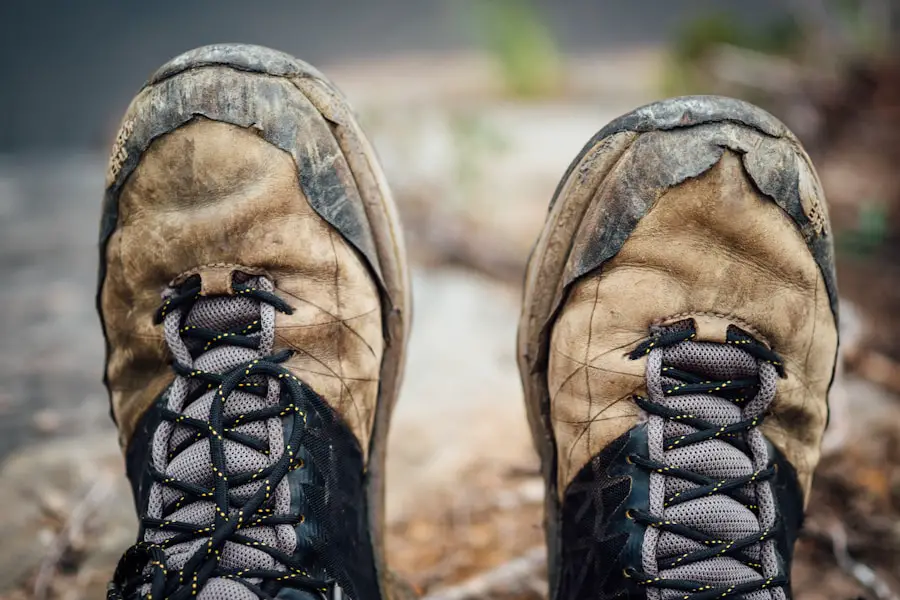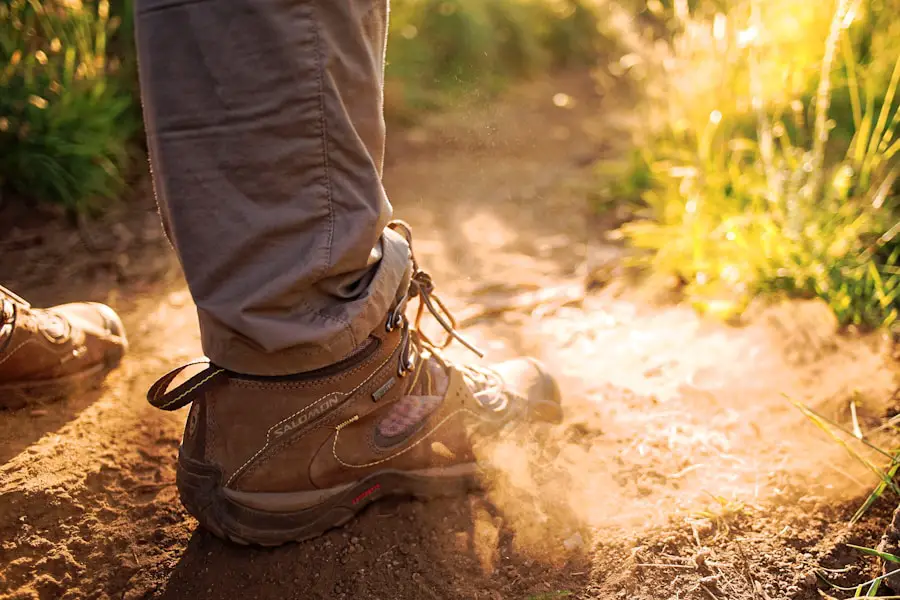Selecting the appropriate hiking shoes is a critical decision for anyone who enjoys exploring the great outdoors. The right footwear can significantly enhance your hiking experience, providing comfort, support, and protection against the various challenges that nature presents. Poorly chosen shoes can lead to discomfort, blisters, and even injuries, which can turn an enjoyable trek into a painful ordeal.
The terrain, weather conditions, and duration of the hike all play a role in determining the best type of shoe for your needs. Therefore, understanding the importance of this choice is paramount for both novice and seasoned hikers alike. Moreover, the right hiking shoes can also impact your performance on the trail.
Shoes that fit well and provide adequate support can improve your stability and balance, allowing you to navigate uneven surfaces with confidence. This is particularly important in rugged terrains where slips and falls are more likely to occur. Additionally, well-designed hiking shoes can help reduce fatigue during long hikes by providing the necessary cushioning and support for your feet.
As such, investing time in selecting the right pair of hiking shoes is not just about comfort; it’s about ensuring safety and enhancing your overall hiking experience.
Key Takeaways
- Choosing the right hiking shoes is crucial for a comfortable and safe outdoor experience.
- Understanding the different types of hiking shoes, such as trail shoes, hiking boots, and approach shoes, can help you make the right choice for your specific needs.
- Key features to consider for comfort and support include cushioning, ankle support, and arch support.
- When looking at material and durability, consider options like leather, synthetic materials, and waterproof membranes for long-lasting performance.
- Traction and grip are essential for hiking shoes, especially for challenging terrains, so look for features like aggressive lugs and sticky rubber outsoles.
Understanding the Different Types of Hiking Shoes
Hiking shoes come in various styles, each designed to cater to specific types of terrain and hiking activities. The most common categories include hiking boots, trail runners, and approach shoes. Hiking boots are typically characterized by their high ankle support and rugged construction, making them ideal for challenging trails and heavy loads.
They provide excellent stability and protection against rocks and roots, which is essential for those who venture into more demanding environments. For example, a hiker tackling a multi-day backpacking trip through mountainous terrain would benefit from the support and durability offered by a sturdy pair of hiking boots. On the other hand, trail runners are designed for speed and agility on less technical trails.
They are lightweight and offer a more flexible fit compared to traditional hiking boots. This makes them suitable for day hikes or fast-paced adventures where weight is a concern. Trail runners often feature breathable materials that help keep your feet cool during warmer months.
However, they may lack the ankle support needed for more rugged terrains, making them less suitable for heavy loads or rocky paths. Approach shoes bridge the gap between hiking boots and climbing shoes, offering a balance of comfort and performance for those who need to navigate both trails and technical rock sections.
Key Features to Consider for Comfort and Support

When selecting hiking shoes, several key features should be prioritized to ensure maximum comfort and support during your outdoor adventures. One of the most critical aspects is cushioning. A well-cushioned shoe can absorb impact and reduce strain on your feet, especially during long hikes on hard surfaces.
Look for shoes with adequate midsole cushioning made from materials like EVA (ethylene-vinyl acetate) or polyurethane, which provide excellent shock absorption while maintaining durability. Another essential feature is arch support. Everyone’s feet have different arch types—flat, neutral, or high—and understanding your foot’s arch can help you choose a shoe that offers the right level of support.
Shoes with built-in arch support can help prevent overpronation or supination, which can lead to discomfort or injury over time. Additionally, consider the shoe’s heel counter; a firm heel counter provides stability and helps keep your foot securely in place while walking on uneven terrain. This combination of cushioning and support is vital for maintaining comfort throughout your hike.
Material and Durability: What to Look for in Hiking Shoes
| Feature | Importance |
|---|---|
| Material | Durable materials such as leather, synthetic leather, and waterproof membranes are important for longevity and protection. |
| Outsole | A durable and grippy outsole made of rubber or Vibram for traction and stability on various terrains. |
| Toe Cap | A reinforced toe cap for protection against rocks and roots on the trail. |
| Midsole | A supportive and cushioned midsole made of EVA or polyurethane for comfort and shock absorption. |
| Waterproofing | A waterproof membrane such as Gore-Tex for keeping feet dry in wet conditions. |
The materials used in hiking shoes play a significant role in their overall durability and performance. Most hiking shoes are constructed from either leather or synthetic materials, each offering distinct advantages. Leather is known for its durability and water resistance, making it an excellent choice for rugged environments.
Full-grain leather shoes tend to be more robust but may require a break-in period to achieve optimal comfort. Conversely, nubuck leather offers a softer feel while still providing decent durability. Synthetic materials, such as nylon or polyester, are often lighter than leather and can offer enhanced breathability.
These materials are typically treated with waterproof coatings to protect against moisture while allowing sweat to escape. When evaluating durability, pay attention to the shoe’s construction methods as well; shoes with reinforced stitching and rubber toe caps tend to withstand wear and tear better than those with simpler designs. Ultimately, the choice between leather and synthetic materials will depend on your specific needs, including the type of terrain you plan to tackle and your personal preferences regarding weight and breathability.
Traction and Grip: Essential Features for Hiking Shoes
Traction is one of the most critical features to consider when choosing hiking shoes, as it directly affects your ability to navigate various terrains safely. The outsole of a hiking shoe is designed with specific tread patterns that enhance grip on different surfaces. Look for shoes with deep lugs made from durable rubber compounds; these features provide better traction on slippery or uneven ground.
Vibram outsoles are particularly renowned for their superior grip and durability, making them a popular choice among outdoor enthusiasts. In addition to lug depth and material, consider the shoe’s tread pattern. A multi-directional tread design can offer better grip when traversing steep inclines or declines by providing traction in various directions.
For instance, if you plan to hike in wet conditions or on muddy trails, opt for shoes with wider spaced lugs that can shed mud more effectively while maintaining grip. The right combination of traction features will not only enhance your stability but also boost your confidence as you tackle challenging trails.
Waterproofing and Breathability: Considerations for Different Environments

When it comes to hiking shoes, waterproofing and breathability are two features that often compete with one another. Depending on the environment in which you plan to hike, one may take precedence over the other. For instance, if you frequently hike in wet or muddy conditions, investing in waterproof shoes is essential to keep your feet dry and comfortable.
Many hiking shoes incorporate waterproof membranes like Gore-Tex or eVent that provide a barrier against moisture while allowing sweat vapor to escape. Conversely, if you plan to hike in hot or dry climates, breathability becomes a crucial factor. Shoes with mesh panels or lightweight synthetic materials can help keep your feet cool by promoting airflow.
However, it’s important to note that highly breathable shoes may sacrifice some level of waterproofing. Therefore, consider the typical weather conditions you’ll encounter on your hikes when making your decision. In some cases, you may even want to invest in two pairs of shoes—one waterproof for wet conditions and another breathable for warmer climates—to ensure you’re prepared for any adventure.
Finding the Right Fit: Sizing and Support for Hiking Shoes
Achieving the perfect fit is perhaps one of the most important aspects of selecting hiking shoes. A well-fitting shoe should feel snug but not overly tight; there should be enough room in the toe box to wiggle your toes without feeling cramped. When trying on hiking shoes, it’s advisable to wear the same type of socks you plan to use on your hikes to ensure an accurate fit.
Additionally, consider trying on shoes later in the day when your feet are slightly swollen from daily activities; this will give you a better idea of how they will feel during extended wear. Support is another critical component of fit that should not be overlooked. A shoe that provides adequate arch support will help distribute weight evenly across your foot, reducing fatigue during long hikes.
If you have specific foot issues such as flat feet or high arches, consider consulting with a podiatrist or footwear specialist who can recommend appropriate options or custom insoles tailored to your needs. Remember that different brands may have varying sizing standards; therefore, it’s essential to try on multiple pairs before making a final decision.
Budget and Value: Balancing Cost and Quality for Hiking Shoes
When it comes to purchasing hiking shoes, budget considerations often come into play alongside quality and performance features. While it may be tempting to opt for cheaper options, investing in a high-quality pair of hiking shoes can pay off in terms of comfort, durability, and overall performance on the trail. A well-constructed shoe made from quality materials will not only last longer but also provide better support and protection against injuries.
That said, there are plenty of mid-range options that offer excellent value without breaking the bank. Researching brands known for their quality craftsmanship can help you find reliable options within your budget. Additionally, consider shopping during sales events or looking for last season’s models; these can often provide significant savings while still delivering solid performance features.
Ultimately, finding a balance between cost and quality will ensure that you invest wisely in footwear that enhances your hiking experience without compromising safety or comfort.
When searching for the perfect hiking shoes, it’s important to consider all aspects of your outdoor adventure. One key factor to keep in mind is the comfort and support provided by the shoes. In a related article on TakeTravelInfo, they discuss the benefits of using a rechargeable hand warmer for travel. This handy device can keep your hands warm and cozy during chilly hikes, ensuring a more enjoyable experience. By clicking on this link, you can learn more about how this small gadget can make a big difference in your outdoor excursions.
Love travel? Join Our Facebook Community For More Tips.
FAQs
What are the important factors to consider when choosing hiking shoes?
When choosing hiking shoes, it’s important to consider factors such as the type of terrain you’ll be hiking on, the level of ankle support you need, the weight of the shoes, and the level of waterproofing required.
What type of terrain will you be hiking on?
The type of terrain you’ll be hiking on will determine the type of hiking shoes you need. For example, if you’ll be hiking on rocky or uneven terrain, you’ll need shoes with a sturdy sole and good traction.
How important is ankle support in hiking shoes?
Ankle support is important, especially if you’ll be hiking on uneven terrain or carrying a heavy backpack. Look for hiking shoes with good ankle support to help prevent injuries.
What is the ideal weight for hiking shoes?
The ideal weight for hiking shoes depends on personal preference and the type of hiking you’ll be doing. Lighter shoes are more comfortable for shorter hikes, while heavier shoes provide more support for longer hikes and rough terrain.
How important is waterproofing in hiking shoes?
Waterproofing is important if you’ll be hiking in wet or muddy conditions. Look for hiking shoes with a waterproof membrane to keep your feet dry and comfortable.
